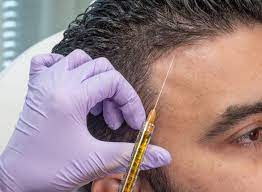Hyperpigmentation is a common skin concern affecting people of all skin types, often resulting in dark patches, uneven tone, and discoloration. With growing interest in natural and regenerative skin therapies, many are asking: Can PRP treatment be used to treat hyperpigmentation? The answer is promising. Platelet-Rich Plasma (PRP) therapy harnesses the body’s own healing mechanisms to address skin issues, including hyperpigmentation. Through its unique ability to repair and renew skin at the cellular level, PRP offers a gentle yet effective solution for pigmentation-related concerns. Let’s explore how Best PRP Treatment(أفضل علاج البلازما الغنية بالصفائح الدموية) works, why it’s important, and what to consider before choosing this treatment for pigmentation problems.
Why PRP Treatment Matters in Hyperpigmentation?
Hyperpigmentation can arise due to sun exposure, hormonal changes, acne scars, or inflammation. It disrupts the skin’s even tone and can be challenging to treat, especially with sensitive or darker skin types. PRP therapy plays a vital role in managing hyperpigmentation because it targets the root of the problem—cell turnover and inflammation.
The key function of PRP lies in its growth factors, which are isolated from the patient’s own blood. When applied or injected into the skin, these growth factors stimulate collagen production, accelerate cellular repair, and enhance skin regeneration. This makes PRP especially important for treating post-inflammatory hyperpigmentation and melasma, where inflammation plays a major role in causing dark patches.
Benefits of PRP for Hyperpigmentation:
PRP offers numerous advantages for those dealing with pigmentation irregularities, making it a strong contender among skin treatments:
Natural Healing Approach: PRP uses your own plasma, reducing the risk of irritation or adverse reactions.
Reduces Inflammation: Helps calm inflammation, which often contributes to new pigment development.
Accelerates Cell Renewal: Promotes shedding of pigmented cells and replaces them with healthier skin.
Improves Skin Texture: Enhances overall tone, brightness, and smoothness, reducing the appearance of dark patches.
Targets Post-Acne Marks: Particularly helpful for acne-related pigmentation by supporting faster skin recovery.
Minimal Downtime: Recovery is generally fast, with little interruption to daily activities.
These benefits make PRP a compelling choice for those seeking a natural, non-invasive way to manage uneven skin tone and stubborn pigmentation issues.
Risks and Considerations for Treating Hyperpigmentation with PRP:
While PRP is generally well tolerated, it’s important to be aware of potential risks and considerations before undergoing treatment:
Mild Redness or Swelling: Common side effects that usually subside within a day or two.
Temporary Flare-ups: Some patients may experience a brief worsening of pigmentation before improvement.
Inconsistent Results: Outcomes may vary depending on the depth and cause of pigmentation.
Multiple Sessions Needed: Noticeable improvements typically require a series of treatments spaced weeks apart.
Not a Quick Fix: Results appear gradually as the skin heals and regenerates from within.
Despite these minor risks, PRP remains a safe and effective option for individuals seeking holistic treatment for pigmentation concerns.
How PRP Works for Pigmentation Correction?
PRP treatment begins with a simple blood draw. The blood is then spun in a centrifuge to separate platelet-rich plasma from red blood cells. This plasma, rich in growth factors and healing components, is then applied topically or injected into targeted areas of pigmentation.
These growth factors stimulate skin cells to regenerate, encourage collagen synthesis, and promote a healthier skin barrier. Over time, this results in improved skin tone, reduced dark spots, and increased brightness. What sets PRP apart is its ability to work in harmony with the body’s biology, treating pigmentation without harsh chemicals or invasive procedures.
Frequently Asked Questions About PRP for Hyperpigmentation:
Is PRP effective for all types of pigmentation?
PRP works best for post-inflammatory pigmentation and mild melasma. It may be less effective on deep-set or hereditary pigment conditions.
Can PRP be used on darker skin tones?
Yes, PRP is safe for all skin tones as it does not involve lasers or aggressive resurfacing techniques that may worsen pigmentation.
How many sessions are needed for visible improvement?
Most individuals see improvement after 3–4 sessions, spaced about 4–6 weeks apart.
Is PRP painful?
Mild discomfort may occur, especially during injections, but numbing creams are often used to minimize pain.
Can PRP be combined with other pigmentation treatments?
Yes, PRP can be safely combined with microneedling or chemical peels for enhanced results, depending on skin tolerance.
Conclusion:
So, can PRP treatment be used to treat hyperpigmentation? The answer is yes—PRP offers a powerful, natural approach to correcting uneven skin tone by stimulating regeneration from within. Its anti-inflammatory properties, ability to enhance cell turnover, and safe compatibility with all skin types make it an effective treatment option for many pigmentation issues. While it may not deliver instant results, its long-term benefits and gentle methodology make PRP an excellent choice for those seeking a holistic, skin-friendly solution to hyperpigmentation.


 :
: